
Victorian and Edwardian
Street Furniture |
|
The
Heritage Group decided in 2006 to carry
out research to discover whether
any examples of the cast iron street urinals and
public conveniences favoured
and
used by the Victorians and Edwardians still existed in
the 21st century.
These items of street furniture are referred to as 'Temples of Convenience' by the author Lucinda Lambton in her book. The
ongoing and progressive increase in the demand
requirements for health and
safety and environmental
health must have speeded the demise of this type
of external toilet facility. Nevertheless, it
was found that urinals still exist around
the country with several still in use, as can be
seen from the examples shown below.
Most of these toilet facilities were provided for male use but two examples have so far been found which were for female use. Birmingham
and
Bristol
are two cities which have retained most of these are
listed Grade II structures. They can also be found in
preserved heritage railways, public parks and open air
museums.
The
majority of the urinals and toilets found to date,
were manufactured by the
firms of Walter Macfarlane & Co, Saracen
Ironworks; George Smith, Sun Foundry; James Allan Snr
& Son, Elmbank Foundry all located
in Glasgow.
|
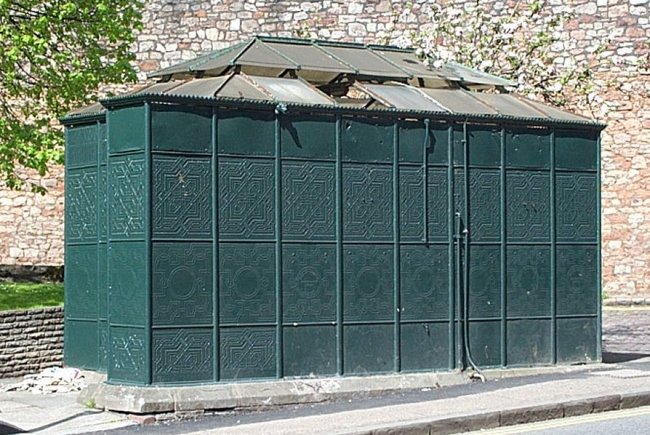
This rectangular double doorway pattern urinal was manufactured
by Walter Macfarlane, and is still in use and can be found in Bristol.

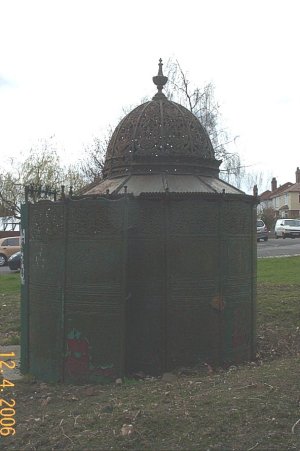 |
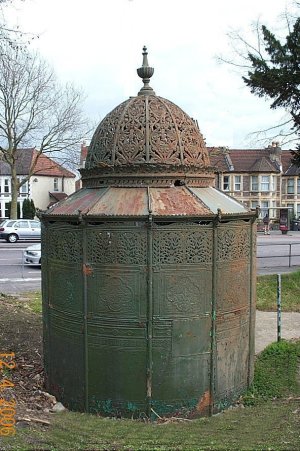 |
| This
circular double doorway pattern urinal is in a very poor
and dilapidated condition, and has now been closed. It
is a Grade II listed structure. Described as a round
pattern with curved entrance screen of decorative panels
pierced to the top, with raking roof to a filigree dome
with bowl finial. Originally with porcelain stall
pattern urinal inside. It was made by George Smith &
Co at their Sun Foundry in Glasgow. It is to found in
north Bristol. However, it was encouraging to find on a recent visit to the area that the local authority had given the Grade II listed structure a complete upgrade, refurbishment with the original paint colour restored, as the two photos below suitably illustrate. |

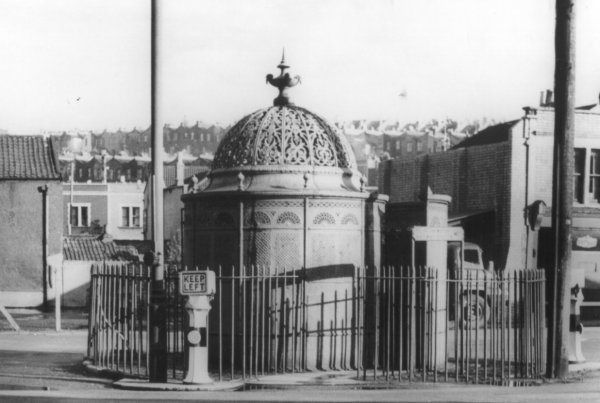
| This
old photograph shows a circular urinal with single
curved doorway in Mill Lane, Bedminster,
Bristol which probably dates from
the Edwardian period. Its shape and pattern is similar
to the designs of Walter Macfarlane of Glasgow. It eventually became stranded on a traffic island, and when the time came for its removal to make way for a road widening scheme, (it was to be moved and re-erected at a local museum), sadly it couldn't withstand the dismantlement and broke into several sections. The remains are now stored in the Bristol Industrial Museum. |
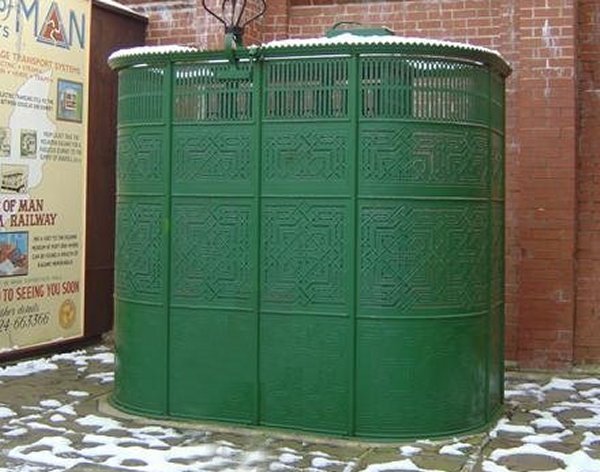
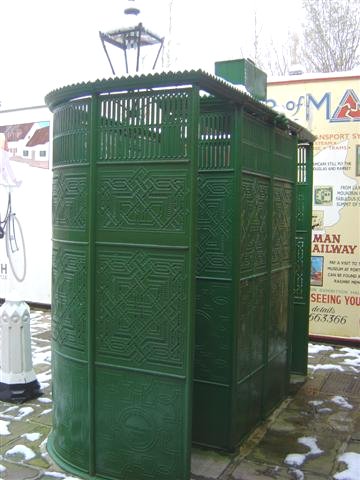 |
This
excellent restored double doorway urinal is on display
at the National Tram Museum
in Crich Derbyshire. It can be found
adjacent to the Red Lion public house as
one of the exhibits and part of the street
scene.
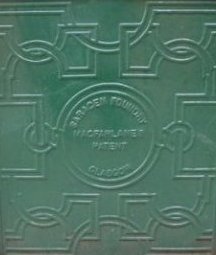 |
Another fine example of a double doorway Urinal is to be found
at the Colyford Station of the Seaton Tramway in Devon.
The name of the manufacturer is not displayed but the pattern on
the panels is similar to those of Lockerbie & Wilkinson of Birmingham.
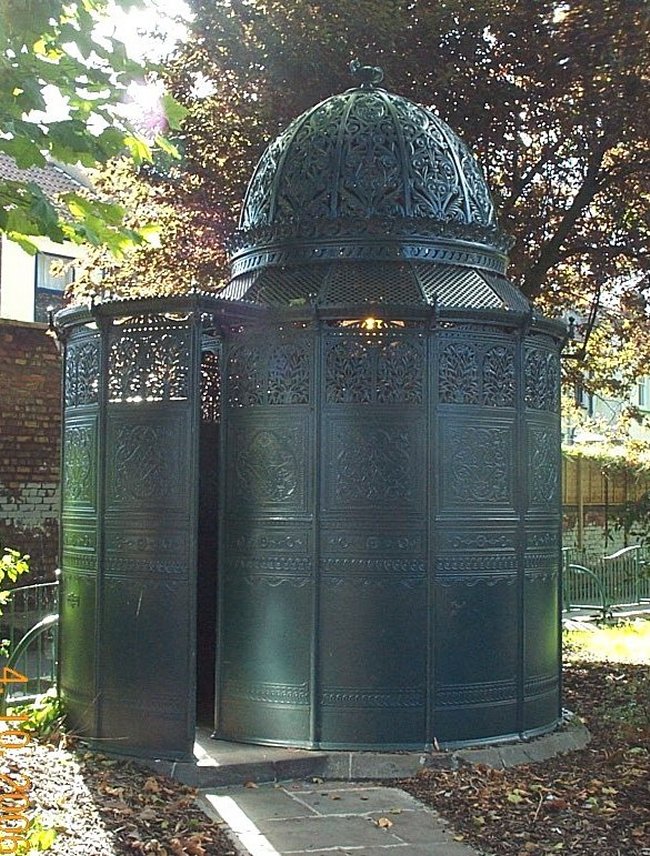
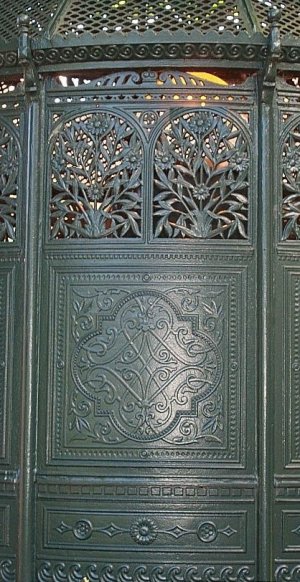 |
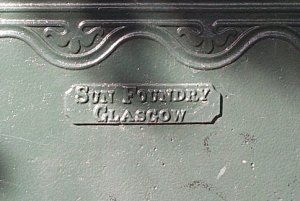
|
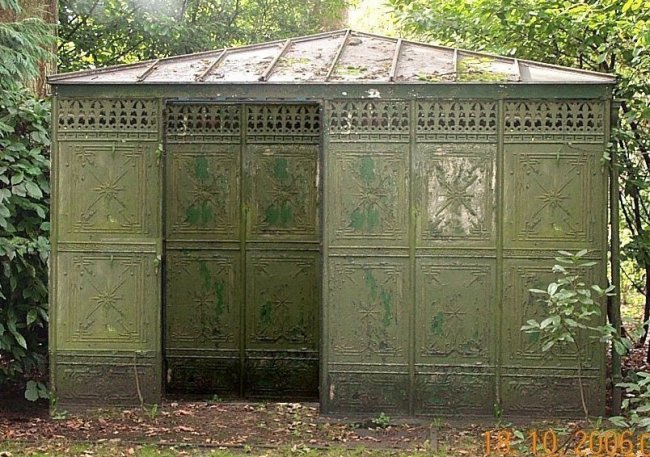 |
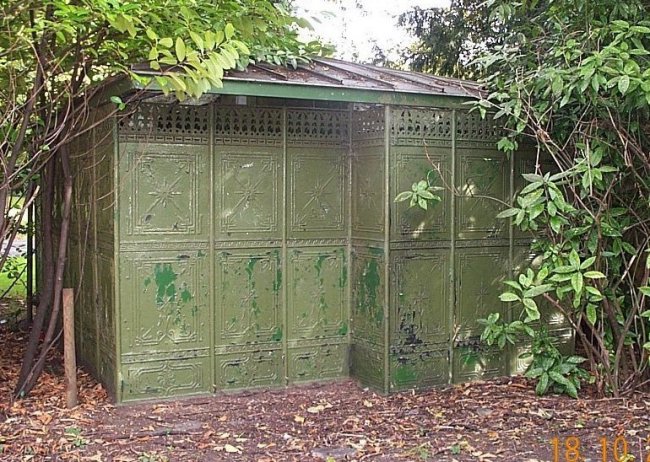 |
| This strangely shaped
rectangular urinal is to be found in Sydney Gardens,
Bath Spa. This is a Grade II listed structure which has unfortunately been allowed to deteriorate and although most of the surrounding trees and bushes have been trimmed back, the branches of trees are detrimentaly affecting the roof of the building. The continuing tree growth will eventually break the panes of the roof glazing. The name of the manufacturer is displayed on a nameplate inside the building which is now inaccessible as the doorway has been closed off and locked. |
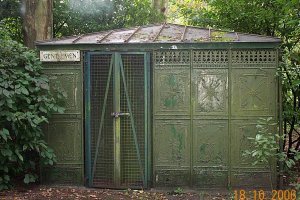 |
The image on the left sadly shows the condition in which the Urinal can now be found. The first large size image has been digitally altered to show how the structure would have looked originally. |
Another working example of a double doorway 4 stall urinal can be found in York House Gardens, Richmond on Thames, London. This Urinal was manufactured by Walter Macfarlane at their Saracen Ironworks in Glasgow. This Urinal is still in use. |
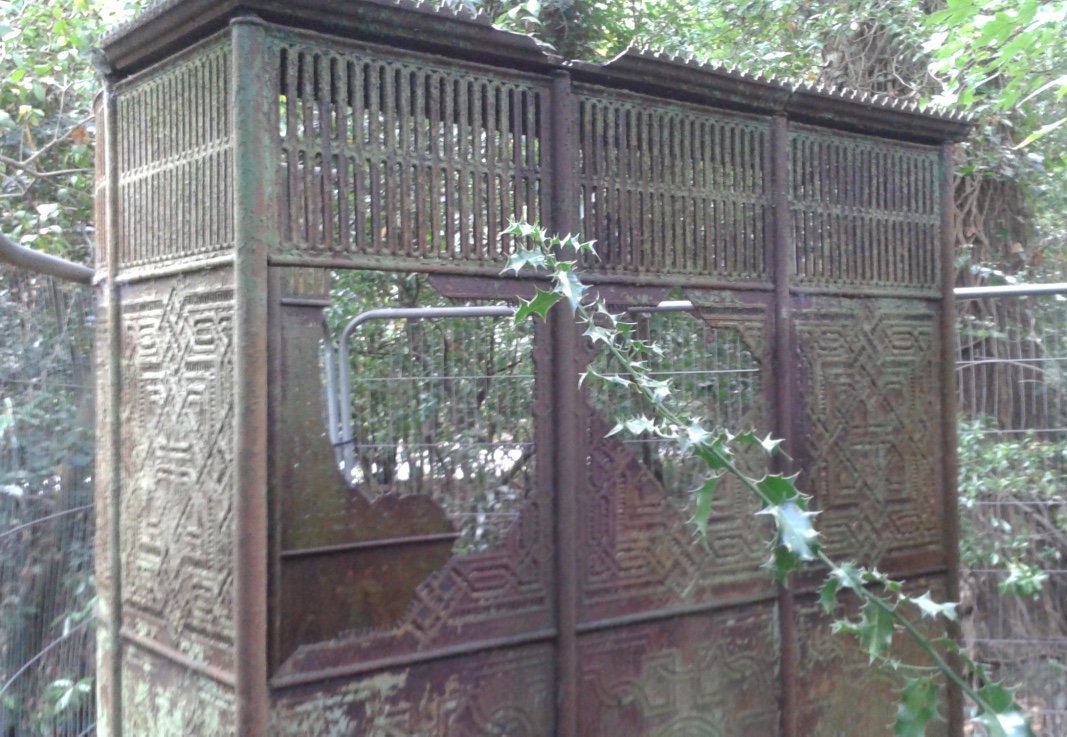
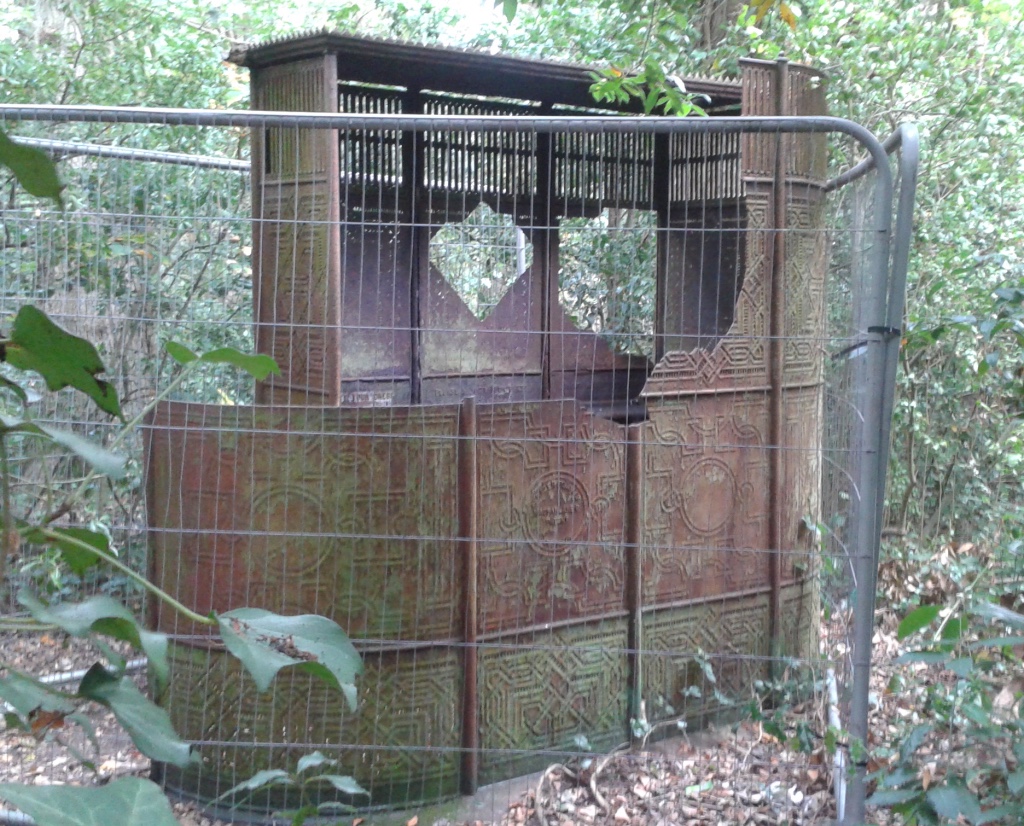
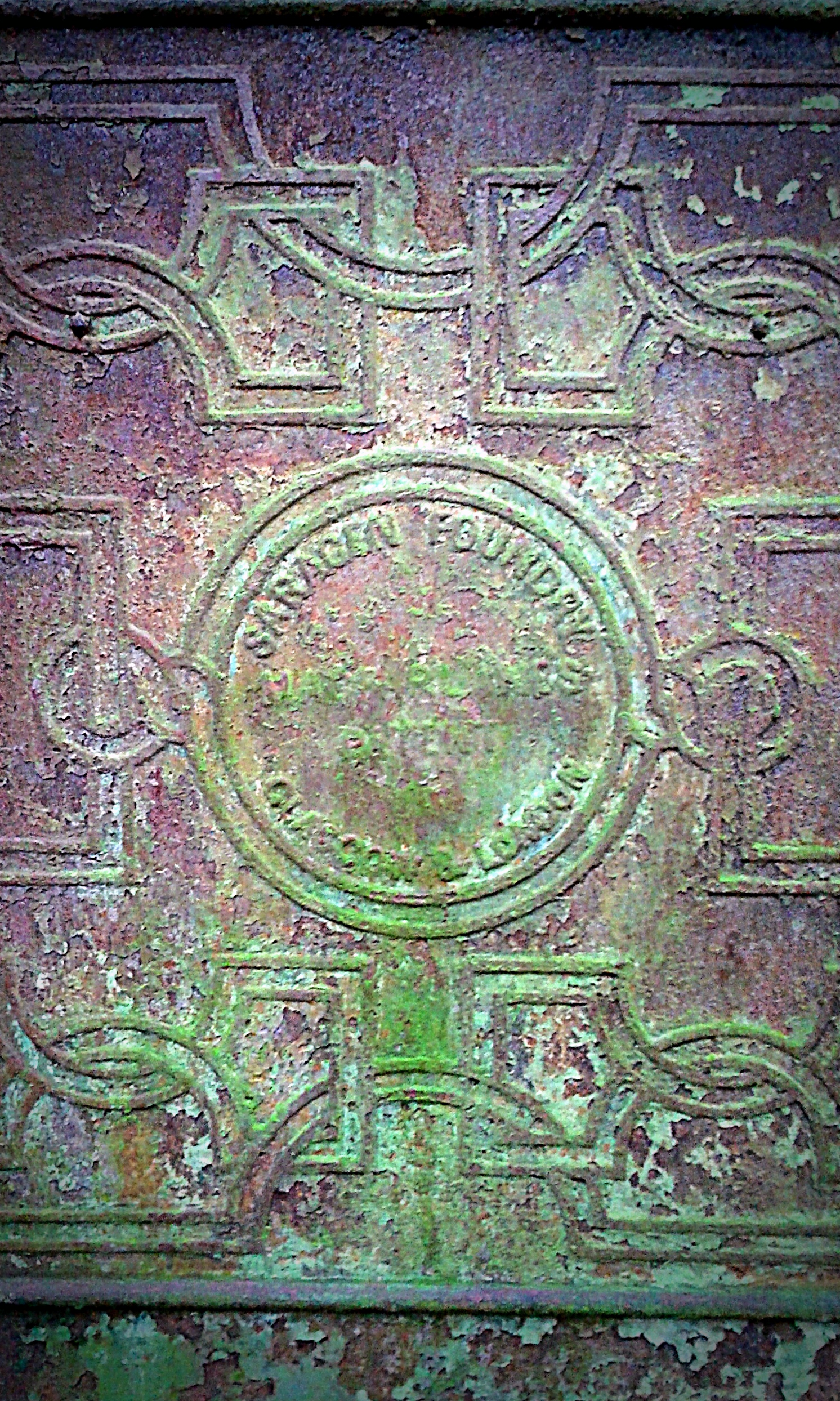 |
What a sorry state This Urinal has suffered much punishment during its long history. It most likely dates from the Edwardian period It was found in a park in Eastborne. |
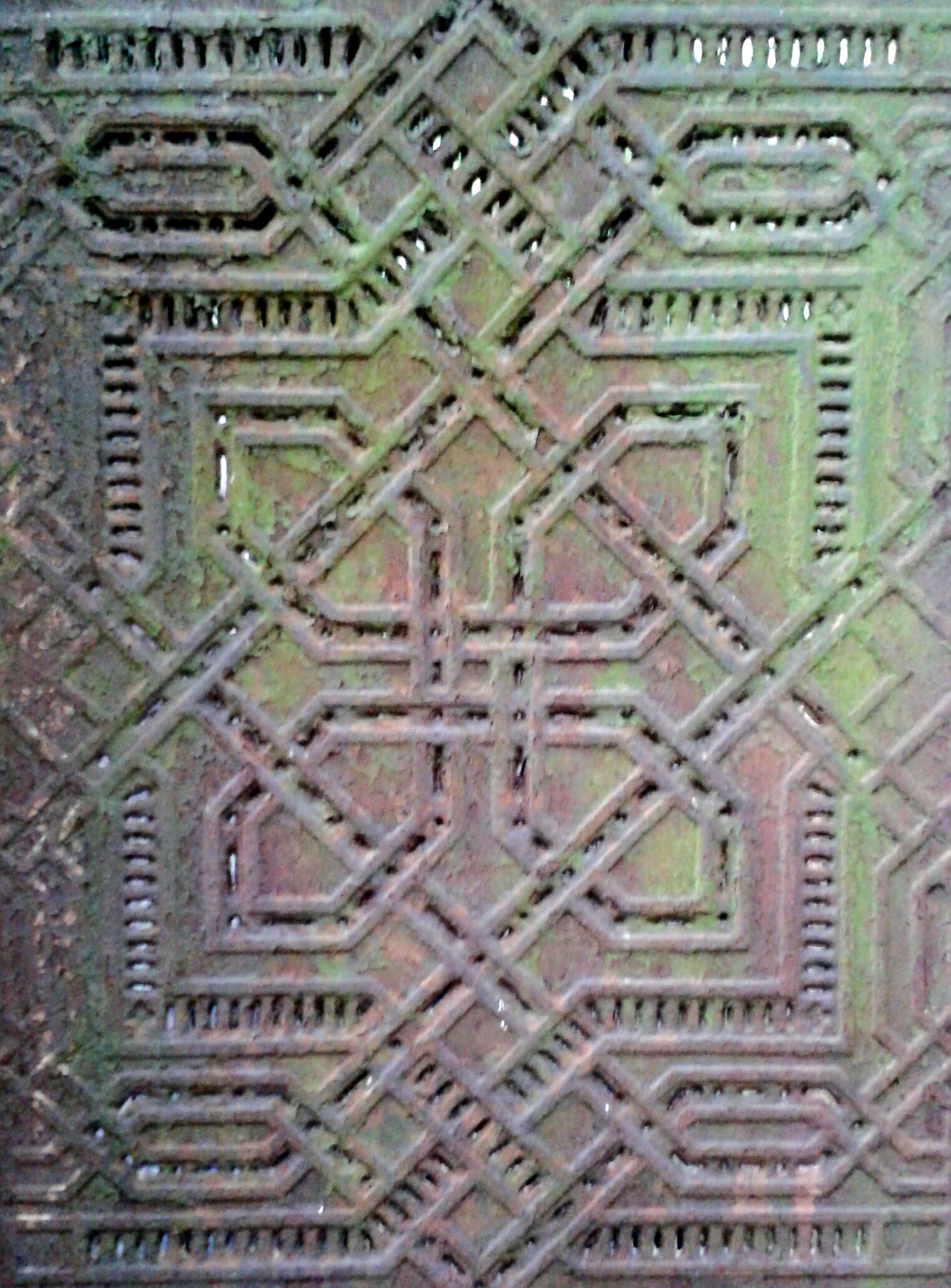 |
This rectangular 3-stall single doorway pattern urinal was manufactured by Walter Macfarlane at their Saracen foundry in
Glasgow. This example is a later version of a Walter Macfarlane cast iron Urinal after it had opened an office in London
These photos were provided by Charles Reynolds
SS GREAT BRITAIN EXHIBITION - BRISTOL
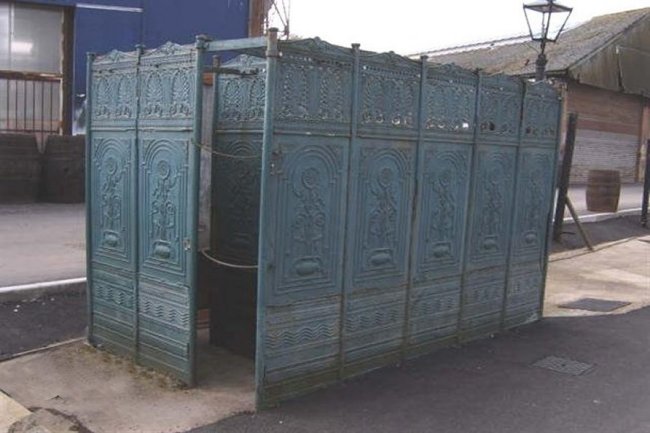
A rare example of a James Allan Snr & Son Elmbank Foundry Glasgow
rectangular single doorway Urinal located on the dockside of the
SS Great Britain exhibition site in Bristol.
The Urinal carries the James Allan Snr & Son nameplate .

When the curtiledge of the dockside site was reduced it became necessary
to relocate the Urinal. This presented the opportunity for the Urinal
to be refurbished and repainted, as shown below.

The Heritage Railways Connection
Another fine example of a single doorway Urinal can be found at the Cranmore Station of the East Somerset Preserved Heritage Railway in Somerset. The name of the manufacturer displayed on one front panel is Walter Macfarlane of Glasgow made at their Saracenfoundry. The urinal is at present undergoing cleaning and repainting refurbishment. |

|
The photos of the Urinal on the Station platform at
Bewdley Worcs. were provided by Brough Skingley.

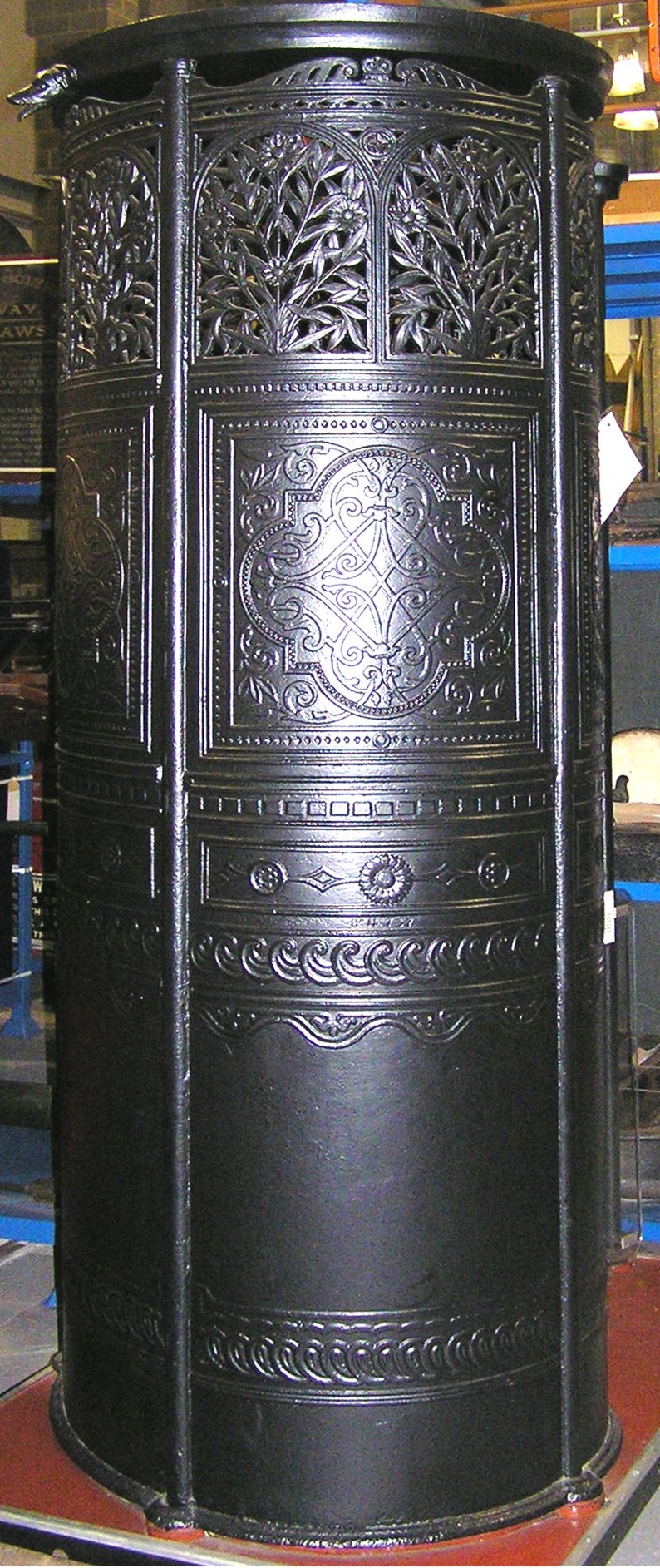 |
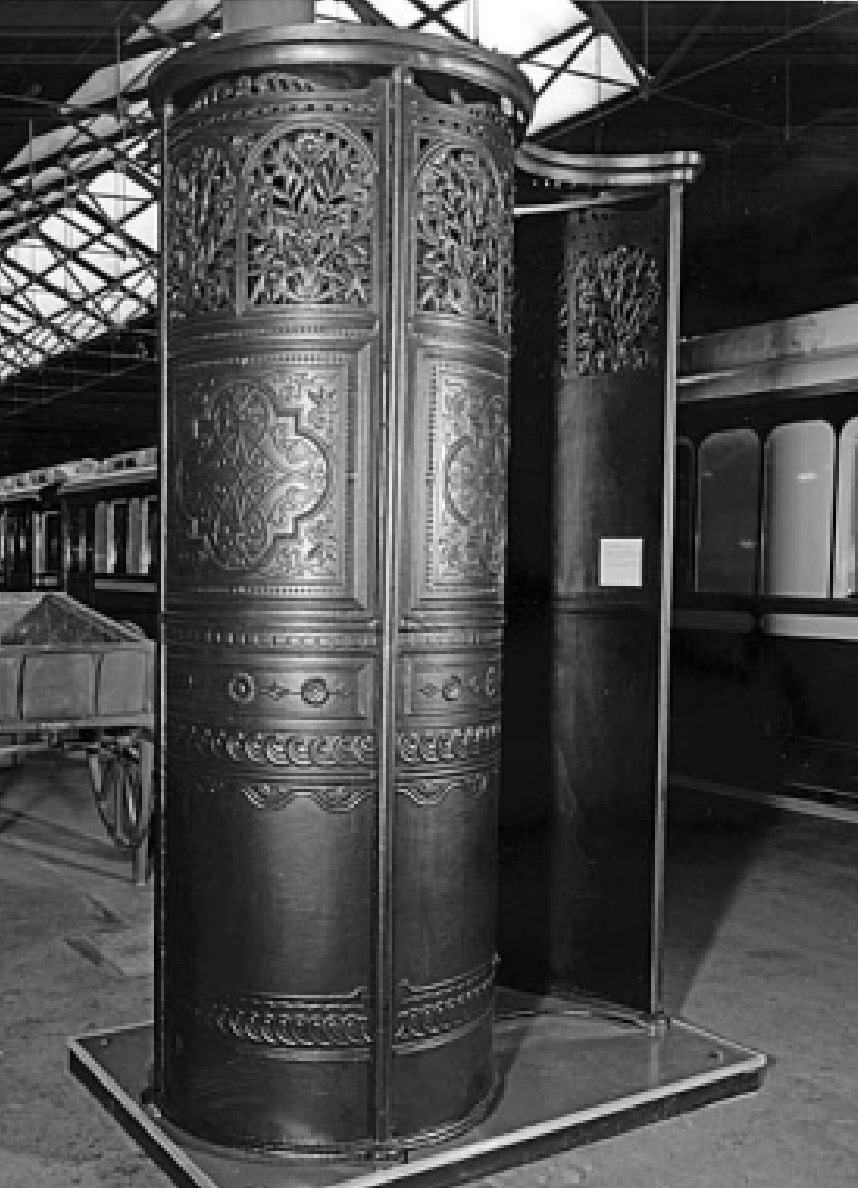 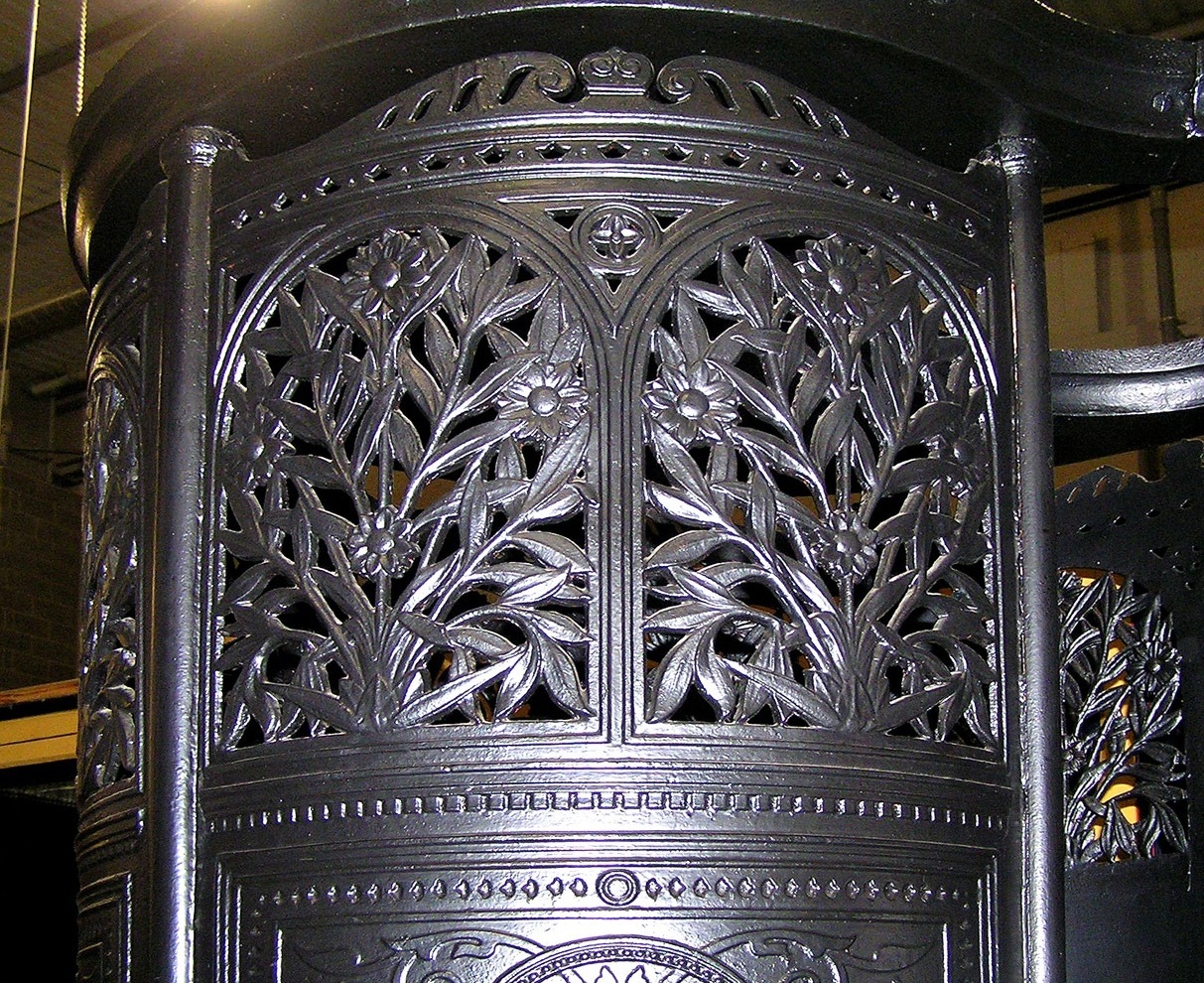 This wonderfully restored single person male cast iron urinal can be found at the National Rail Museum in York. It was originally sited on the platform at Curthwaite rail station in Cumberland on the Maryport & Carlisle Railway. It was made by George Smith & Co at their Sun Foundry in Glasgow. |
The photos of the Urinal were provided by
John Bolton - Scottish Ironwork Foundation.
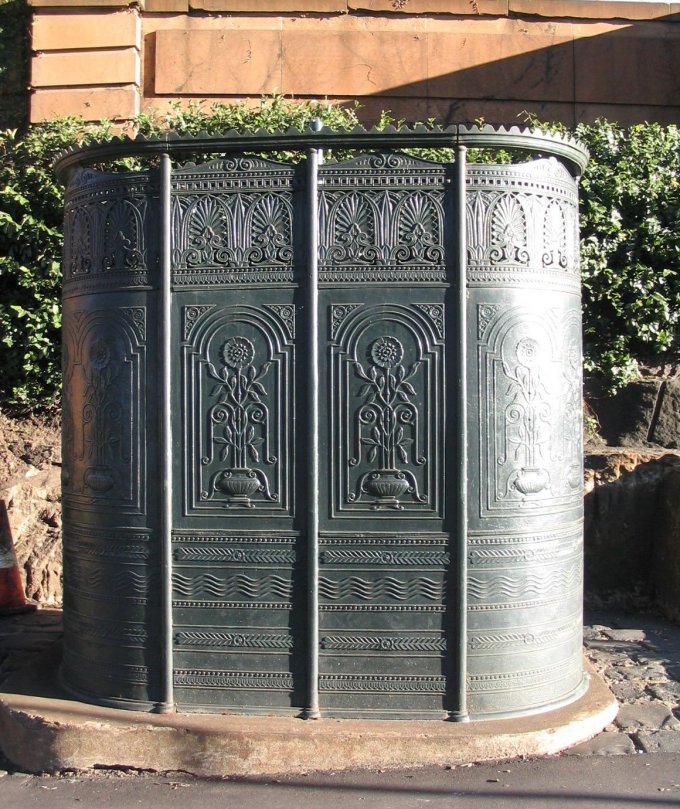 |
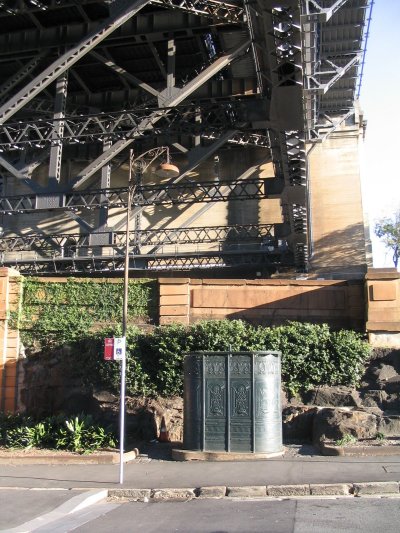 |
This
excellent example of a double doorway urinal
to a design of James Allan Snr & Son
Elmbank Foundry Glasgow, is in
a remarkably preserved condition and
can be found on the roadway under the Sydney harbour
bridge in Australia.
The irony of its location is that although here is a toilet facility provided for male relief the notice on the adjacent lampost says NO STOPPING. |
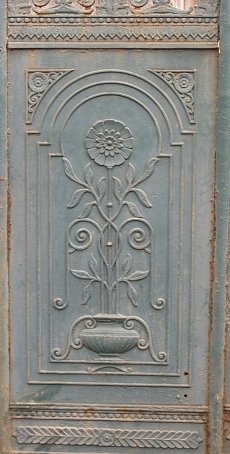 |
The name marked on the urinal is B G Plummer & Co Sydney, but comparison of the floral design on the Sydney (right hand side) panels shows an almost perfect copy with the panels (left hand side) found on the Urinal at the S.S. Great Britain exhibition site in Bristol, England. It
must follow that B G Plummer had
an agreement with James Allan Snr & Son of Glasgow
to manufacture their Urinals in Australia.
|
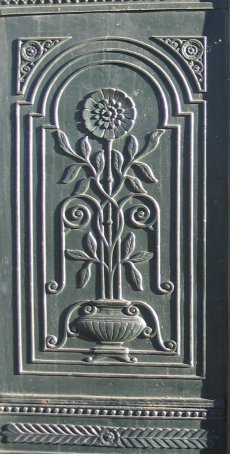 |
The photos of the Urinal under Sydney Harbour Bridge in
Australia were provided by Paul Yunnie of the Heritage Group.
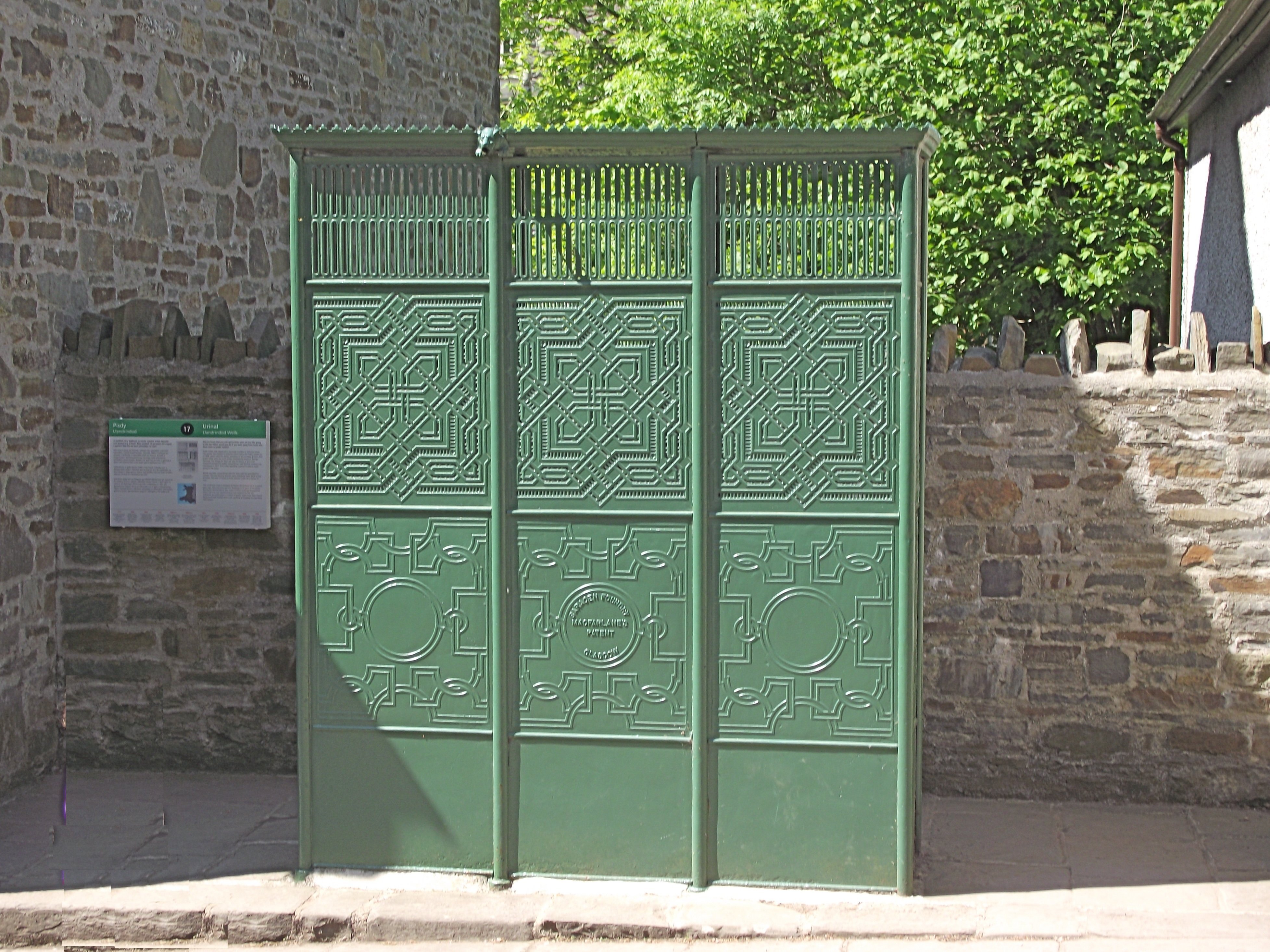 |
|
This fine restored example of a Walter Macfarlane Cast iron urinal made at their Saracen Glasgow Foundry was manufactured during the Edwardian period. It can be seen at the Museum of Welsh Life, St Fagan's, Cardiff. The Urinal was transferred from Llandrindod Wells, Powys where it is understood to have been sited on the platform of the railway station. |
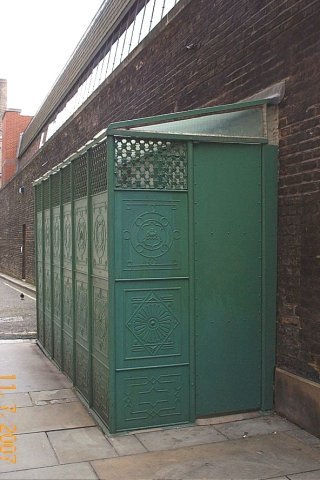 |
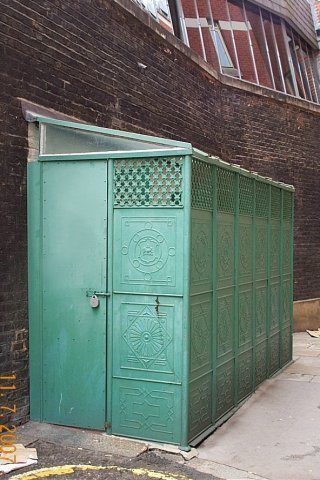 |
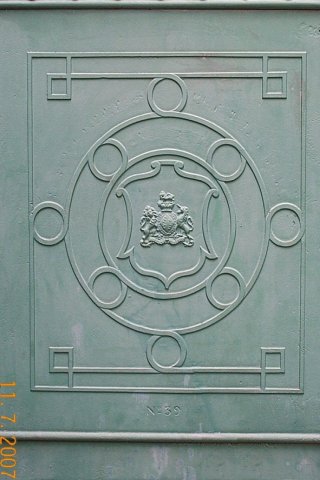 |
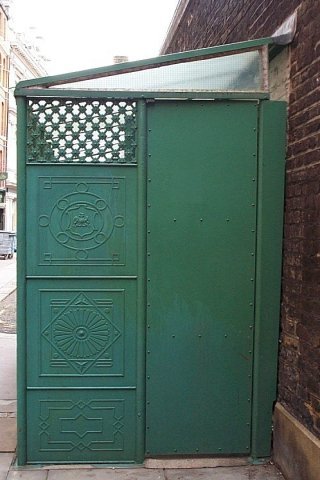 |
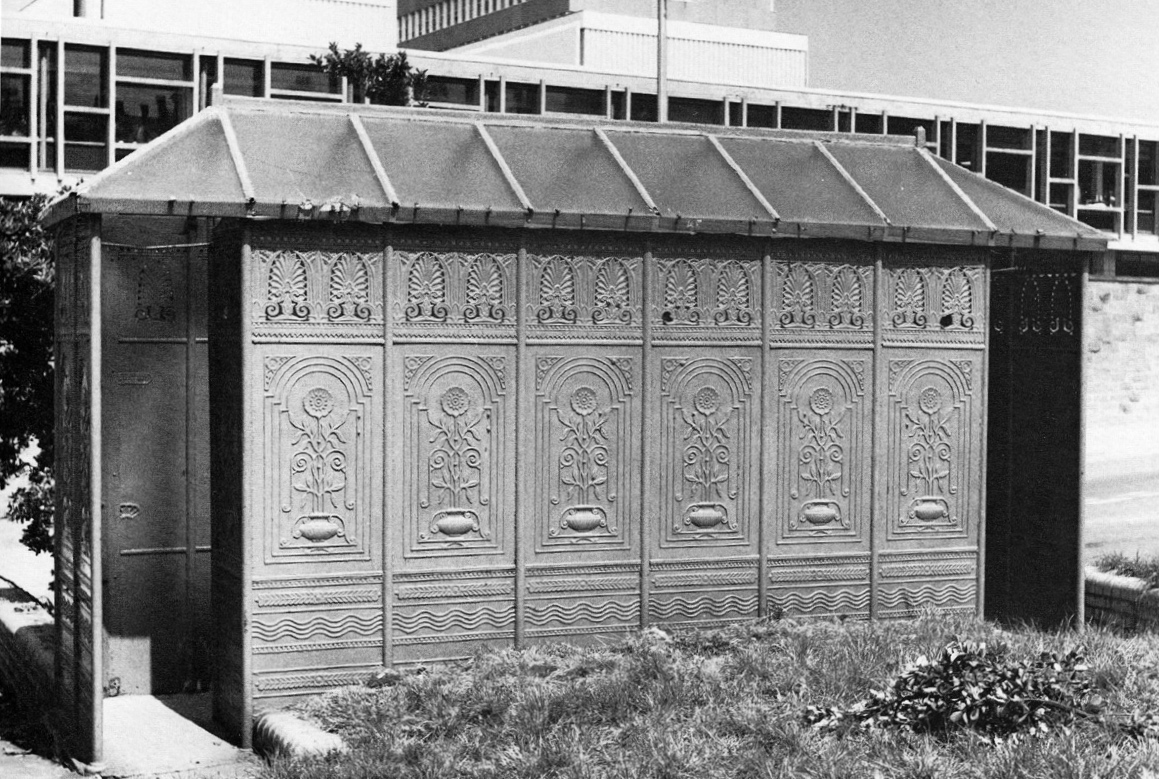
This double entrance door rectangular Urinal stood at the entrance to the
dockyard in Ferry Road, Devonport.
This photograph is shown in the 'Pillar to Post' 1982 book by Henry Aarons.
It suitably shows the excellent condition it was kept in for its age.
The manufacturer is James Allan Senr & Son of Elmbank Works Glasgow.
It had 6 stalls and a pitched Georgian wired glazed roof.


When this later photograph was taken sadly the urinal had been allowed
to lapse into this very poor state of disrepair. It has since been dismantled
and removed to storage in a local Museum.
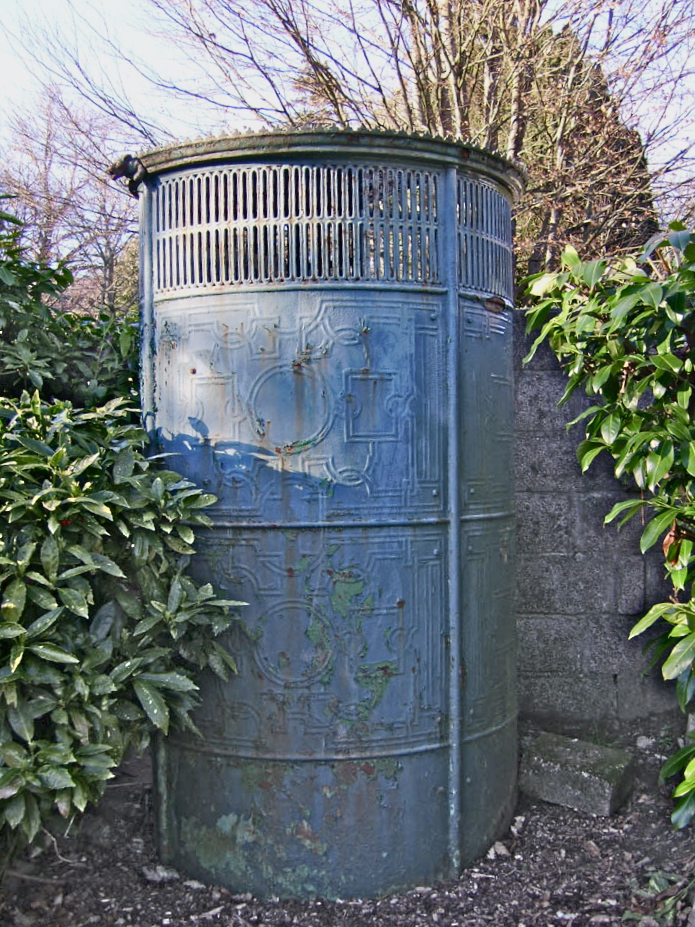
This unusual single person round urinal is located in Thorn Park, Plymouth.
It was manufactured at the Saracen Ironfoundry of
Walter MacFarlane in Glasgow

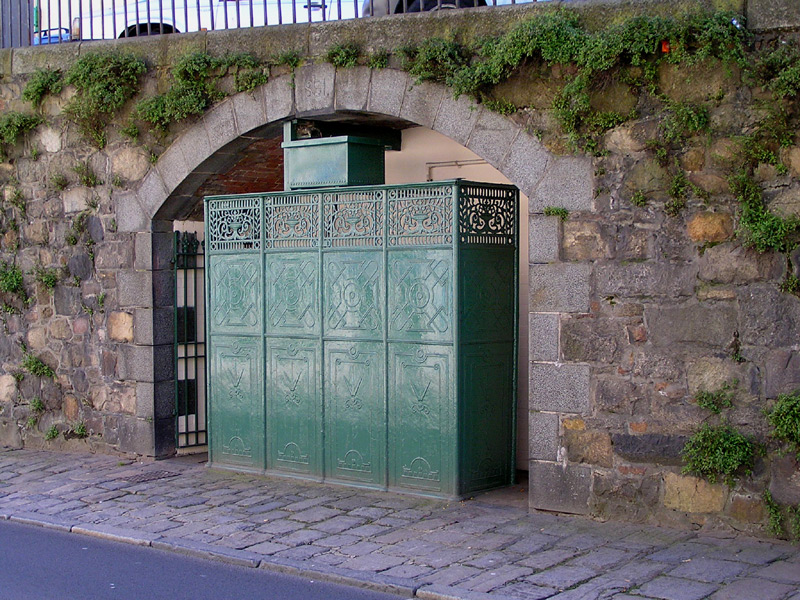
The photos of the Urinal at St Peter Port Guernsey
were provided by John Bolton Scottish Ironwork Foundation.
This delightful setting for a rectangular cast iron urinal can be found
at le Bordage, St Peter Port, Guernsey, Channel Islands. The mounting
at high level of the coldwater header tank gives it a different appearance.
The manufacturer is James Allan Senr & Son of Glasgow.
The Church Connection
| Occasionally
cast
iron urinals can be found sited in the grounds of
Churches or Cemeteries. Why this has happened is
open to suggestion. Three examples of this
arrangement are shown below. |
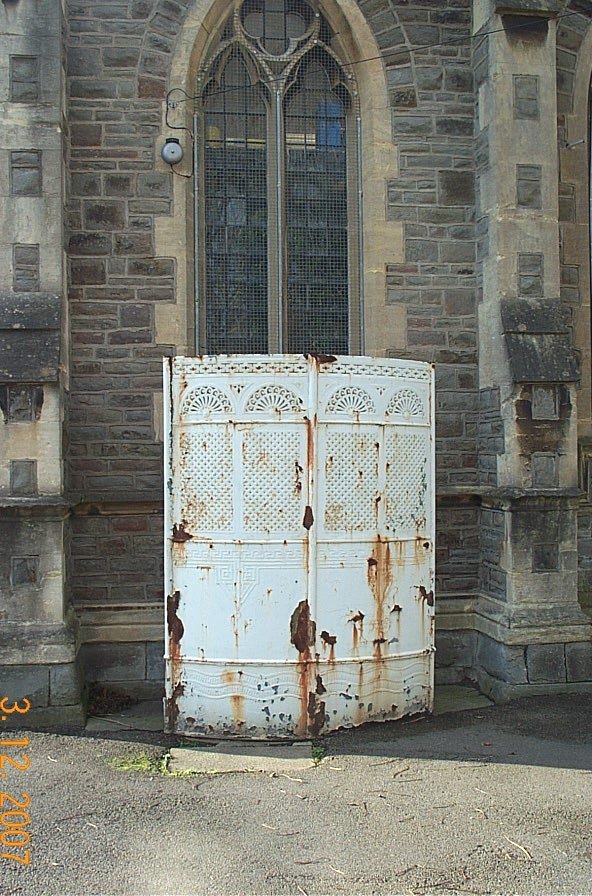 |
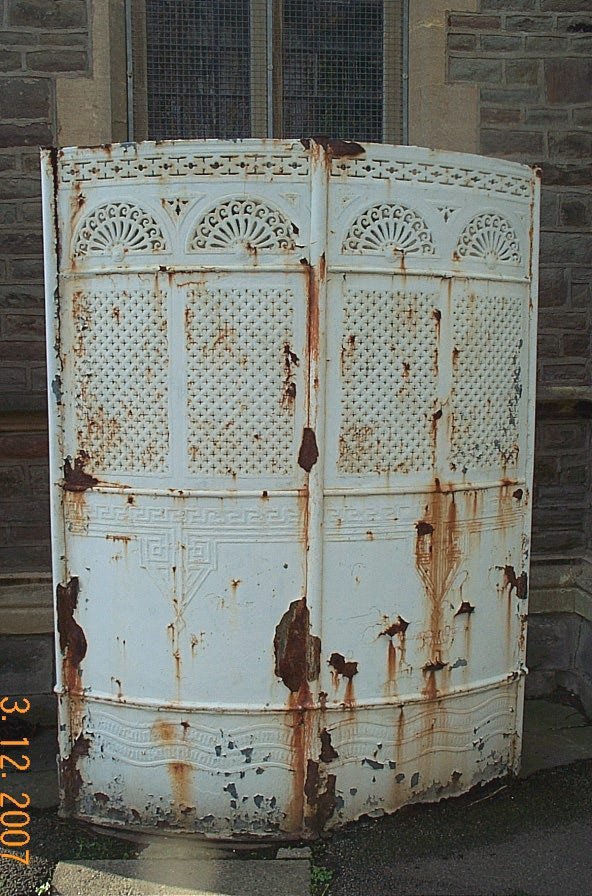 |
These two sections taken from another dismantled urinal sadly are
in a very dilapadated condition and can be seen installed against the
outside wall of a church in an east Bristol cemetery.
Manufacturer unknown.

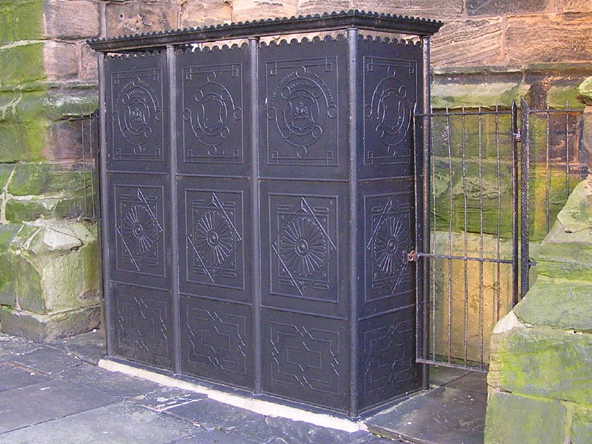 |
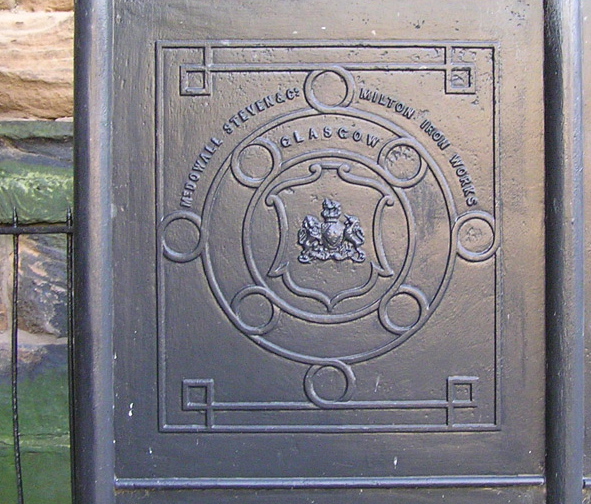 |
These two photos of the Urinal in Ormskirk were provided
by John Bolton - Scottish Ironwork Foundation.
In complete contrast is this urinal sited in the grounds of an Ormskirk Church
which is in excellent condition complete with security gate to deter vandalism.
The manufacturer is McDowall Steven & Co. Milton Ironworks Glasgow.
But sadly shown below in stark contrast is this urinal sited in the grounds
of another Ormskirk Church that shows the ultimate condition of ironwork
when left to the ravages of the weather.
Possibly this urinal is the only surviving example of a
Walter Macfarlane No 5 for use by one person.
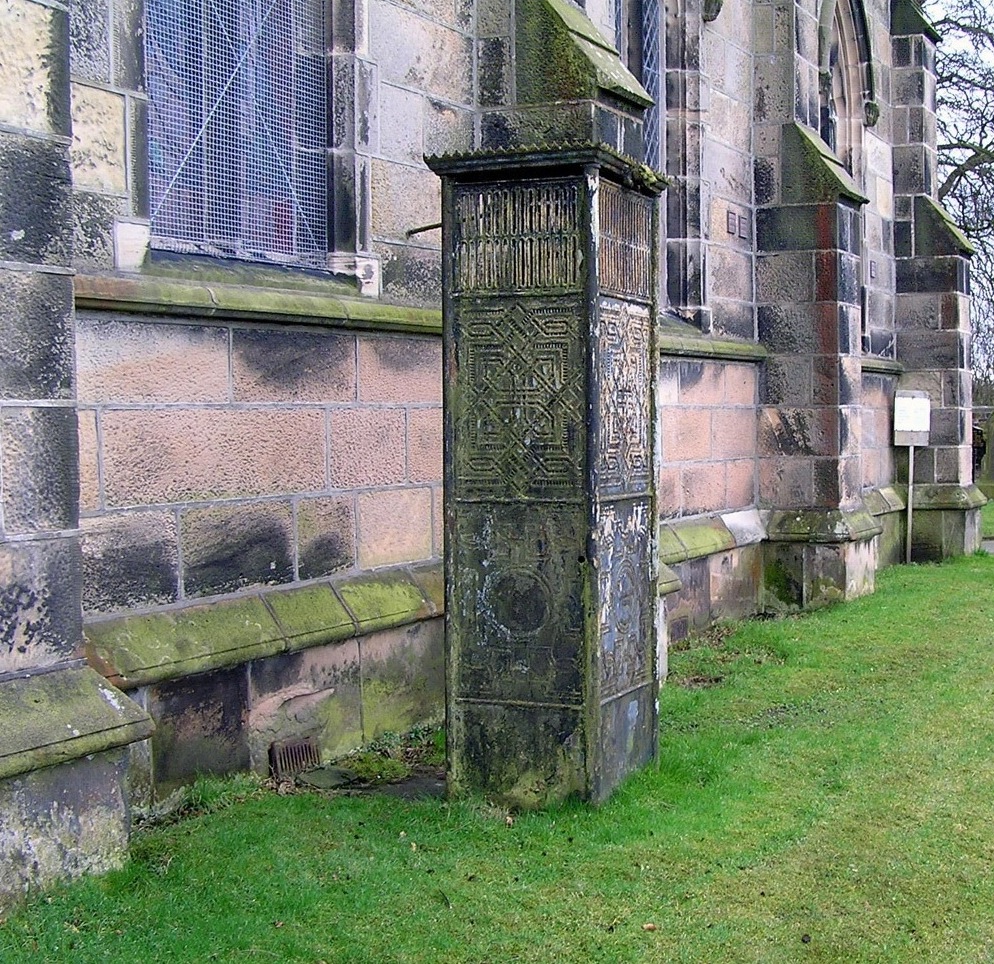
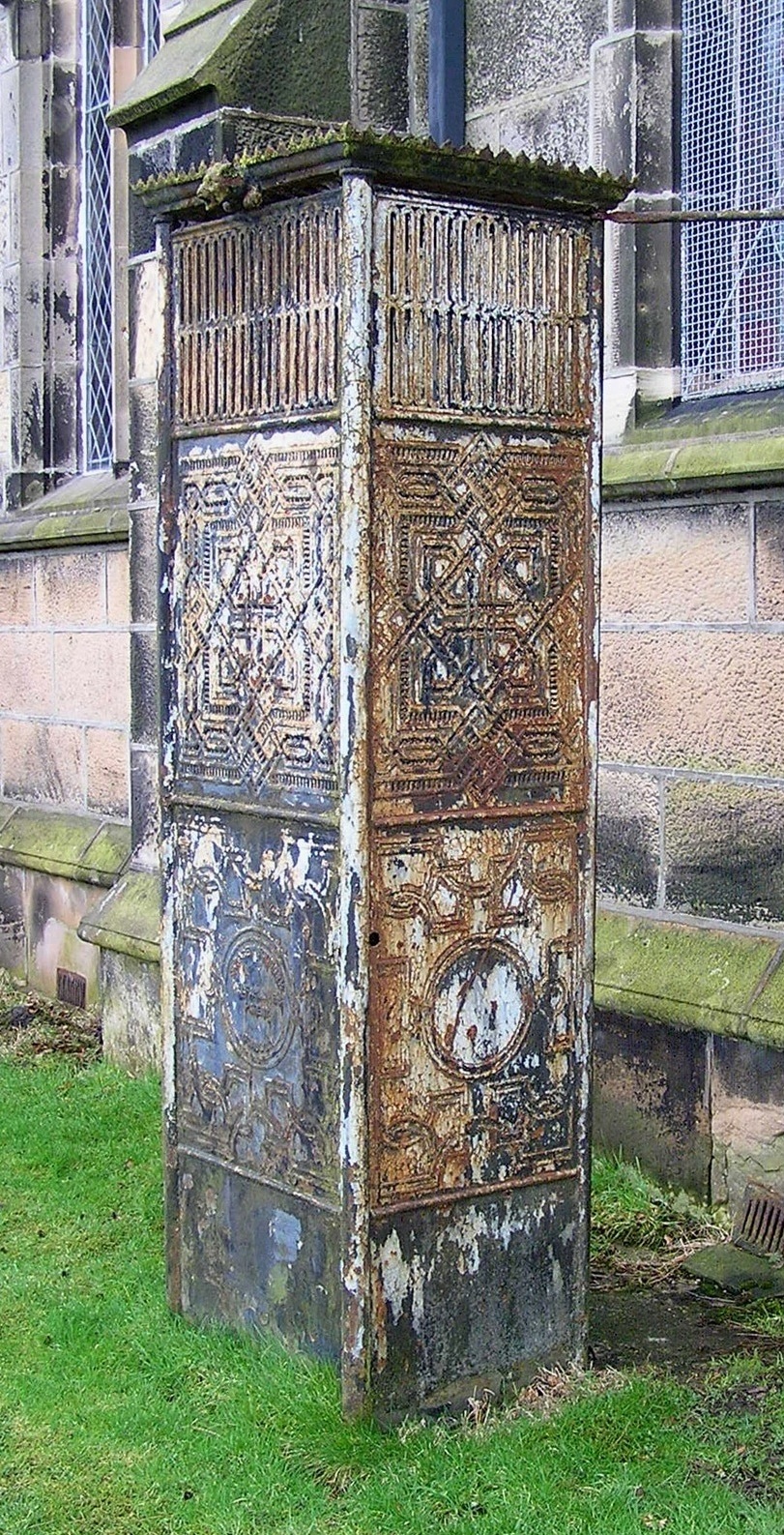
The two photos of this Urinal in Ormskirk were
provided by John Bolton - Scottish Ironwork Foundation.

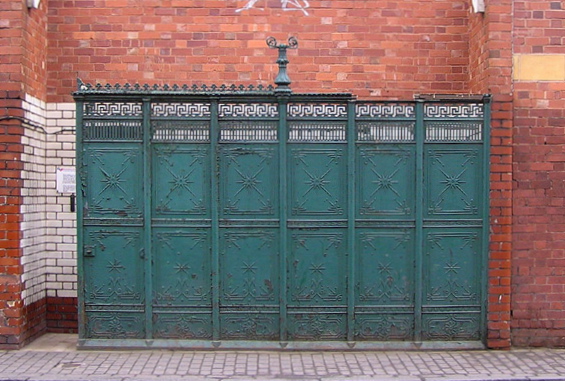 |
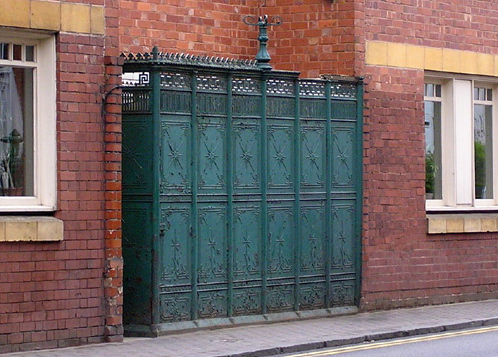 |
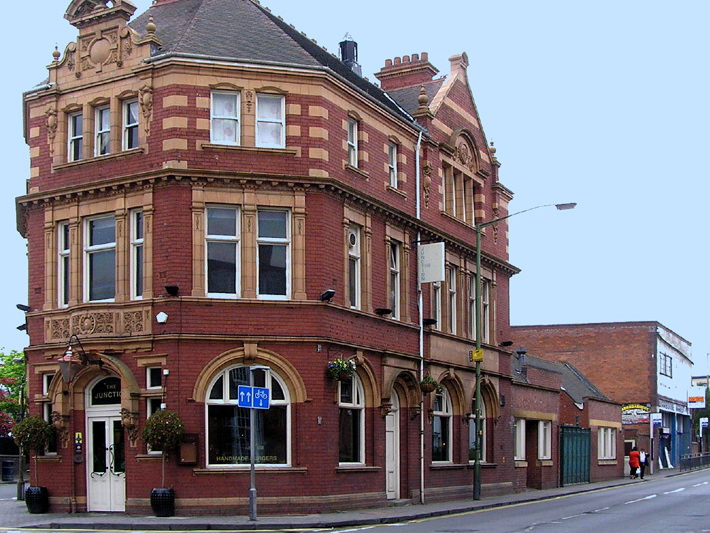 |
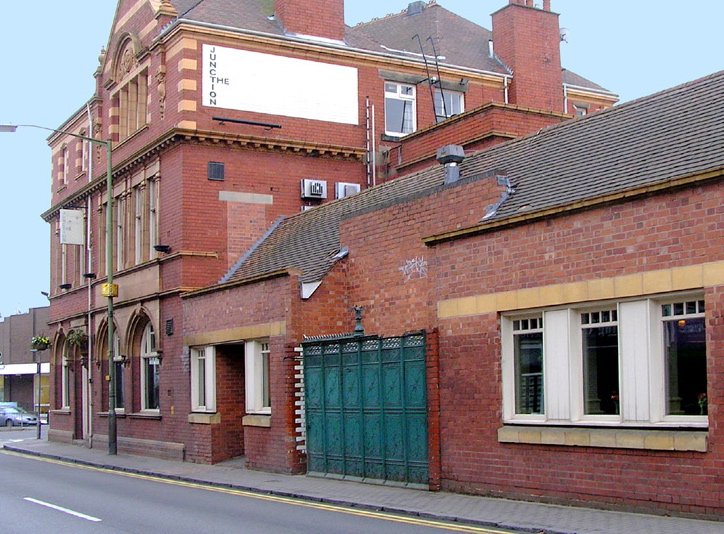 |
The four photos of the Urinal in Harborne Birmingham were
provided by John Bolton - Scottish Ironwork Foundation.
This 6 stall Urinal possibly installed as a separate item of pavement
street furniture appears to have been absorped into the layout of the
Public House building when it was extended at a later date. No makers
name is noted on any of the cast iron panels, but the pattern on the
panels bare a resemblance to the Lockerbie & Wilkinson design.

This 5 stall rectangular urinal manufactured by Walter Macfarlane is located
adjacent to the railway station in the Jewellery Quarter of Birmingham.
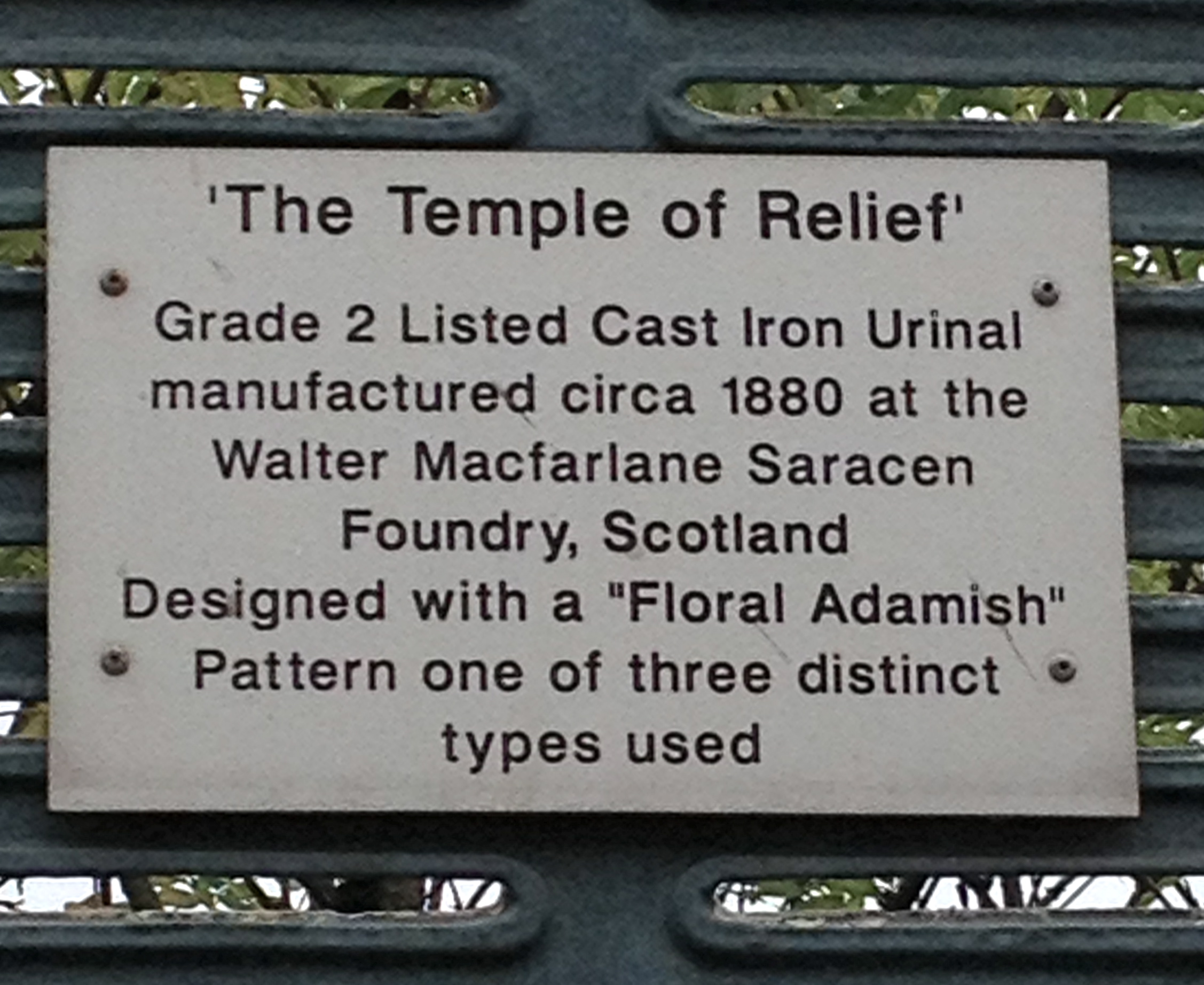
The photos were provided by John Clibbens.
CHILTERN OPEN AIR MUSEUM
CAVERSHAM PUBLIC CONVENIENCE WHICH
CELEBRATES ITS CENTENARY IN 2006
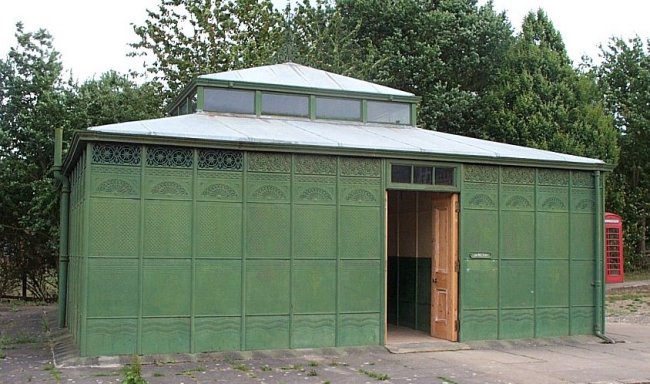
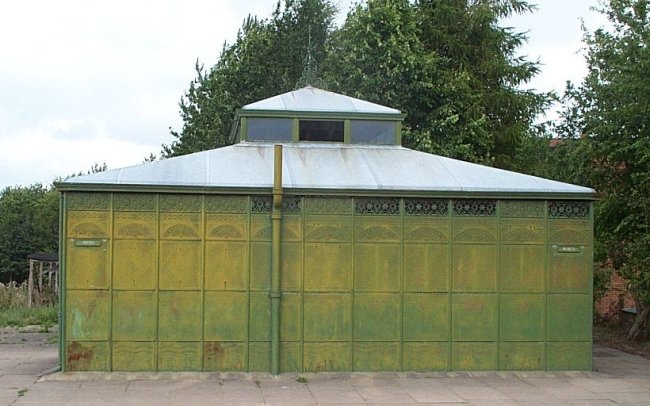
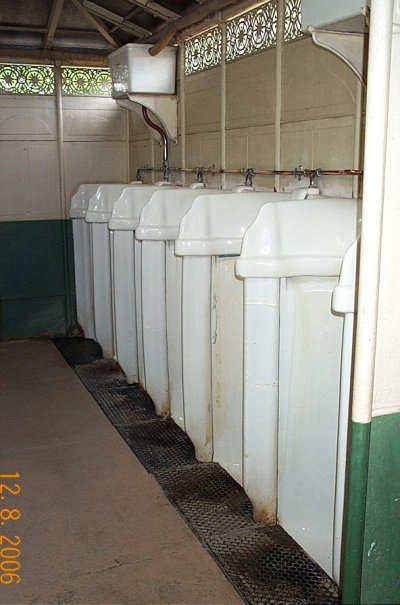 |
When this Public Convenience that was sited in Caversham Berkshire was considered by Reading Borough Council to have reached the end of its useful life, it was closed. The year was 1980, and alternative uses were then considered, but none found to be suitable. The
toilet was originally purchased by Reading Borough
Council in 1906, and provided for the use of
passengers using the tramway at its Caversham
terminus.
The
cast iron decorated panel structure is partitioned
suitable for separate male and female use, and was
manufactured at the Saracen Ironfoundry of Walter
MacFarlane & Co. in Glasgow.
In
1985 the building was donated by Reading Borough
Council to the Chiltern Open Air Museum. Its team of
dedicated volunteers then dismantled, removed and
rebuilt it in its present location between the years
1987 and 1991. It was finally opened in 1992 to
provide public toilet facilities for the Museum.
|
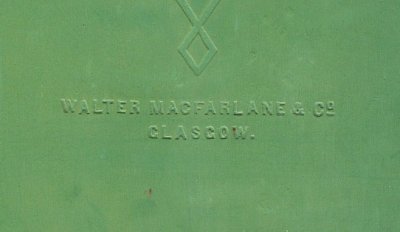
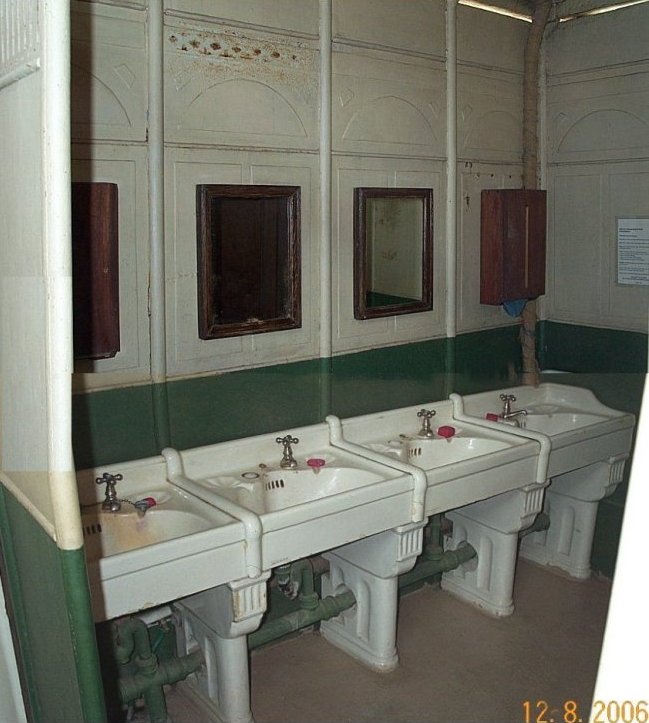
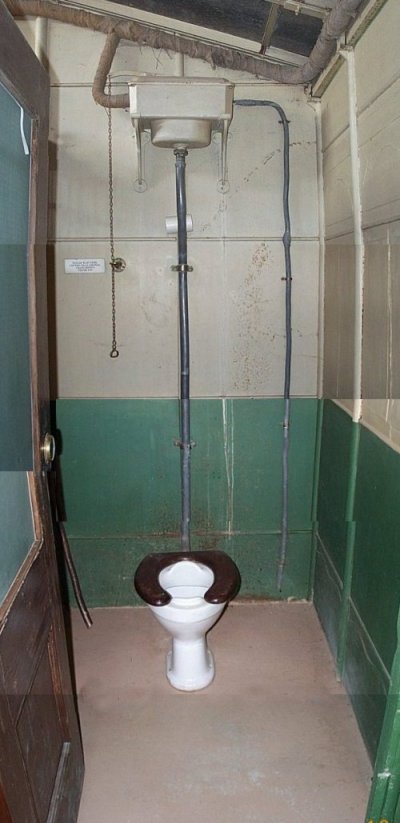 |
Both
male
and female toilets are provided with toilet
cubicles (one cubicle has been adapted for
disabled persons), and a room with hand wash
basins. In addition the male toilet is fitted with
several stall pattern urinals.
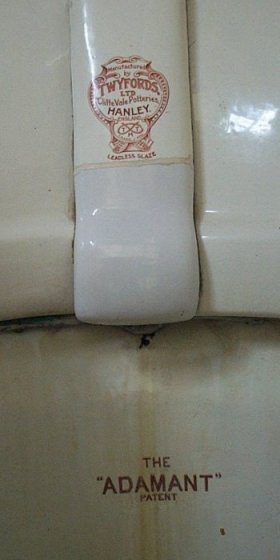 |
The Heritage Group acknowledges the help and assistance
provided by the Chiltern Open Air Museum in the preparation
of this webpage.
top of page
August
2006


